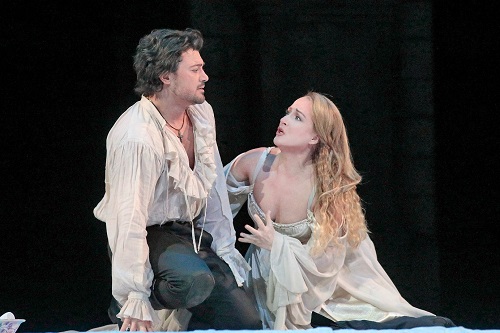 United States Gounod, Roméo et Juliette: Soloists, Chorus and Orchestra of the Metropolitan Opera New York / Gianandrea Noseda (conductor), Broadcast live to the Komedia Cinema, Brighton, from the Metropolitan Opera New York, 21.1.2017. (RB)
United States Gounod, Roméo et Juliette: Soloists, Chorus and Orchestra of the Metropolitan Opera New York / Gianandrea Noseda (conductor), Broadcast live to the Komedia Cinema, Brighton, from the Metropolitan Opera New York, 21.1.2017. (RB)

Cast:
Juliette – Diana Damrau
Stéphano – Virginie Verrez
Roméo – Vittorio Grigolo
Mercutio – Elliot Madore
Frère Laurent – Mikhail Petrenko
Tybalt – Diego Silva
Count Capulet – Laurent Naouri
Production:
Production – Bartlett Sher
Set Designer – Michael Yeargan
Costume Designer – Catherine Zuber
Lighting Designer – Jennifer Tipton
Choreography – Chase Brock
Fight Director – B.H. Barry
Live in HD Director – Gary Halvorson
Live in HD Host – Ailyn Pérez
Gounod’s Roméo et Juliette was first performed in Paris in 1867, almost ten years after the success of Faust. It has never achieved the same popularity as Faust although it contains some of the composer’s most romantic music and memorable melodies. While some of the music can seem a little mawkish nowadays, there is much to admire in the score and the opera probably deserves a more central place in the repertoire.
Bartlett Sher’s new production for the Met transports the action from 16th to 18th century Verona. An imposing three storey palazzo formed the backdrop to the set and props were kept to a minimum to allow for fluid scene changes. The costumes were bright, varied and colourful, particularly in the slightly surreal masked ball scene. A large white sheet fulfilled various functions in the production: initially it floated down from the ceiling in one of the early party scenes and was then transformed into a sheet to cover the married lovers’ bed before finally becoming an all-enveloping wedding dress for Juliette in the preparations for her impending marriage to Paris.
In spite of the shift to the 18th century this was a very traditional production of the opera. It did not offer any significant new insights into the story of the star crossed lovers but it was nevertheless gripping as drama and as spectacle. The opening scene was dark and sombre and there was very little movement from the cast who faced the audience stony-faced. There was then an immediate transformation into the scene at the Capulets’ masked ball which was full of flamboyant costumes and Broadway dance sequences. There was tremendous athleticism from the two leads and at one point we saw Vittorio Grigolo’s Roméo scaling the walls of the balcony. The fight scene in the third Act was brilliantly choreographed by B.H. Barry and the performers threw themselves into the sword fights with swashbuckling aplomb. Gounod’s music is enormously varied in the way it evokes particular scenes and Sher’s production complemented this beautifully, allowing the action to unfold in a seamless way.
Italian tenor Vittorio Grigolo and German soprano Diana Damrau were both superb in the title roles. Grigolo’s performance was spellbinding and he produced the best singing and acting of the evening. He has a rich, warm, highly coloured voice that seems particularly apt for this role and he moved seamlessly from charged outbursts to seductive whisperings and heartfelt romantic longing. Grigolo’s performance in the balcony scene in particular was incandescent as he embodied the hot headed and love struck Roméo to perfection. There were a few technical glitches with the transmission in the final scene when Grigolo was singing his farewells to his love but his extraordinary performance remained gripping in spite of this. Damrau captured the giddiness of the young Juliette to perfection and commanded attention whenever she was on stage. There were a few very minor intonation problems in one of the early scenes but thereafter she executed Juliette’s flighty coloratura with razor sharp precision. ‘Je veux vivre’ was dispatched with flair, vivacity and lightness of touch while the ‘Poison aria’ was full of dramatic intensity and we could see Juliette visibly wrestling with the quandary of whether or not to drink the potion. Occasionally I would have welcomed a little more warmth from Damrau but this is a minor quibble in what was otherwise a first rate performance.
Gounod gives the title characters four duets throughout the opera and Grigolo and Damrau performed them beautifully, producing gorgeous, perfectly blended vocal lines. There was a real chemistry between the characters which made the ardour and romance completely believable and compelling. While there was no doubting the quality of the performances from Grigolo and Damrau they received sterling support from the rest of the cast. Elliot Madore’s rendition of Mercutio’s aria, ‘Mab, la reine des Mensonges’ had an elfin lightness and delicacy while he captured the indignation and irascibility of the character brilliantly in the third Act. Virginie Verrez acquitted herself well in the trouser role of Stephano, bringing a bright tone and exquisitely executed embellishments to ‘Que fais-tu, blanche tourterelle’. Laurent Naouri and Diego Silva also did very well in the roles of Count Capulet and Tybalt although I would have welcomed a little less vibrato from Silva.
Gianandrea Noseda did a superb job keeping the cast, chorus and orchestra on track. He controlled the shifts of mood and atmosphere well, moving adeptly from the dark, sombre opening to the jaunty ball scene. The Met orchestra produced rich, dark sonorities in the balcony scene, providing a velvety cushion of sound for the performers and the balance of sound was excellent throughout. I enjoyed the scampering of the woodwind in Mercutio’s aria and the visceral excitement created during the fight scene. The Metropolitan Opera Chorus was on fine form throughout and brought the warring factions of Shakespeare’s tale winningly to life.
Overall, this was an excellent production with the plaudits deservedly going to Grigolo and Damrau.
Robert Beattie